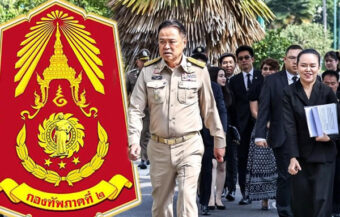Thailand’s economy faces a perfect storm of political deadlock, soaring debt, weak exports and rising deflation risks. With growth projected at just 1.4–1.8% in 2025 and a critical US tariff deadline looming, fears of a deeper crisis are rapidly mounting.
As Thailand’s political factions clash over cabinet appointments and the fallout from a tense border dispute with Cambodia, the economy continues to deteriorate. Current projections suggest the country will grow by just 1.4–1.8% in 2025. However, deeper structural issues may be even more alarming. A growing credit crunch is not only squeezing household budgets but is also reportedly affecting major corporations that anchor the national economy. At the same time, Thailand’s manufacturing sector is steadily shrinking, amid rising concerns that recent export growth may be driven by Chinese transshipments rather than genuine recovery. Meanwhile, opposition leader Sirikanya Tansakul has raised her concern over escalating public borrowing, declining core state revenue and the looming threat of deflation in an economy that appears to be slowly suffocating.

Thailand’s economy is under severe pressure as political instability, trade uncertainty, and weak domestic demand converge. The situation is growing increasingly fragile. Rival factions in government remain locked in a political standoff, while tensions with Cambodia escalate at the border. As a result, economic policy has taken a backseat.
Domestic consumption is falling steadily. More alarmingly, household debt—which has previously shown signs of improvement—is now threatening to rise again. This reversal, as yet based on unofficial reports has alarmed policymakers and banking executives alike.
Foreign tourism, a key driver of Thailand’s economy, is also struggling. Visitor numbers are lower than expected. Although the government forecasts 35 to 37 million tourist arrivals in 2025, the sector remains weak. Many hoped for a strong recovery post-pandemic, but that optimism is now fading.
China’s dumping, transhipment fears, and looming US tariffs threaten Thailand’s key export sector
Meanwhile, China is dumping unsold products into Thai markets. These goods, blocked from the United States due to tariffs, are now flooding local shelves. Consequently, Thai producers face fierce price competition, adding strain to domestic industries.
Adding to the complexity, there are signs of re-export schemes. In March and April, Thai exports saw a brief rebound. However, experts suggest this was driven by Chinese goods transshipped through Thailand to avoid US tariffs. If true, this trend may trigger new scrutiny from Washington.
Furthermore, Thailand faces a critical deadline. The US’s reciprocal tariff regime—imposed during the Trump administration—expires on July 8. If no new agreement is reached, Thai exports may face tariffs as high as 36%. So far, Finance Minister Pichai Chunhavajira has confirmed that no formal negotiation date has been set.
This delay is deeply concerning. Most trading nations have already begun talks with the US. Thailand, however, has not. With fewer than 30 days left, the window for a deal is rapidly closing. If talks do not begin soon, Thailand may lose vital export markets.
Growing reliance on China and a widening credit crunch shake confidence in Thailand’s economic core
Thailand’s deepening dependence on China is also raising concerns. Meetings now underway between US and Chinese officials at Lancaster House in London are being watched closely. These talks may shape the region’s economic direction. Thailand’s fate could be influenced by decisions made far beyond its borders.
Internally, the financial system is showing signs of distress. A nationwide credit crunch is tightening the flow of capital. Previously, this issue mainly affected grassroots borrowers. Now, even large Thai corporations are struggling to raise funds.
Kasikorn Research Center has issued a sobering economic forecast. It expects Thailand’s GDP to grow just 1.4% in 2025. It warned of a potential technical recession in the second half of the year. This assumes risk factors remain contained. However, many indicators point to further deterioration.
If US tariffs hold steady at 10% throughout 2025, Thai exports may expand by 0.5%. In that case, GDP growth could reach 1.8%. But that projection depends on favourable external conditions. As things stand, most signals suggest tightening trade and investment conditions ahead.
Industrial decline, tighter lending and shrinking fiscal space deepen Thailand’s structural weaknesses in 2025
Kasikorn analysts highlight several red flags. First, industrial output is shrinking. Second, consumer goods imports continue to rise. They now account for over 30% of all retail sales. Third, domestic car sales are expected to fall 1.7% year-on-year in the second half.
Lending is also contracting. Banks are now more cautious. Kasikorn has revised its loan growth estimate from a 0.6% increase to a 0.6% decline. Private sector demand for credit has slowed. Debt repayments are rising. Lenders remain deeply concerned about growing NPLs.
Although NPLs are unlikely to exceed 3% of total loans, they are still rising. In response, financial institutions are restructuring debt and selling bad loans. These measures may ease pressure but are unlikely to reverse the overall trend.
Fiscal pressures are mounting as well. People’s Party MP Sirikanya Tansakul issued a stark warning this week. Public debt could hit 69% of GDP in fiscal year 2026. The legal ceiling is 70%. Therefore, the government will soon have very little room to borrow more.
Debt is projected to reach ฿13.5 trillion. That leaves just ฿210 billion in available borrowing capacity. Unless the ceiling is raised, new spending initiatives will be nearly impossible. Sirikanya urged the Finance Ministry to explain how it will manage this crisis.
Deflation, shrinking tax revenue and use of emergency funds threaten Thailand’s fiscal credibility on markets
She also warned that deflation risks are rising. Purchasing power is weakening across all sectors. The Bank of Thailand, she said, must address these risks. So far, central bank responses have lacked clarity.
Tax revenue shortfalls have added to the crisis. In 2024, collections fell nearly ฿80 billion below target. The government relied on dividends from PTT Plc and the Vayupak Fund to close the gap. Unfortunately, 2025 is repeating the pattern.
Excise tax revenue has already missed the mark by ฿33 billion in the first seven months of the fiscal year. To make up the difference, state enterprises must find 26.5% more revenue. Sirikanya questioned whether this was realistic, given the slowing economy.
Tobacco taxes, for example, have dropped by ฿20 billion since 2017. This is due in part to illegal e-cigarettes and smuggled cigarettes. Demand for legal tobacco products is falling, making recovery unlikely.
The 2026 budget includes ฿3.78 trillion in spending. Yet revenue shortfalls mean the government will likely dip into the central contingency fund. This fund is meant for emergencies, not routine expenditures.
Rising interest gaps, downgraded growth outlooks and lost business confidence signal a rocky road ahead
Interest payments on existing debt also missed budget targets. In fiscal 2024, only 8% of owed interest was paid. The government had planned for 11.3%. The shortfall was covered using treasury reserves.
This year, the government plans to pay just 9.2%. However, actual interest due in fiscal 2026 is estimated at 11.5%. Sirikanya questioned the purpose of medium-term budget plans if they are consistently ignored.
World Bank economists have also weighed in. They recently revised Thailand’s 2025 GDP projection down to 1.8% from 2.9%. This is the country’s slowest growth in 17 years.
Independent economist At Pisanwanich agreed with the downgrade. He attributed 60% of the decline to US trade policies. Another 10% stems from global geopolitical tensions. The remaining 30% comes from Thailand’s own political instability.
The lack of a clear stimulus plan and urgency seen as dragging down private sector and business sentiment
According to At, the US-China tariff dispute still casts a long shadow. Even though negotiations are progressing, other issues remain unresolved. Disputes over Taiwan, chips, rare minerals, and even transatlantic trade continue to slow global recovery.
He also warned that Thailand’s failure to begin trade talks with Washington is risky. Other countries have already “started counting day one.” Thailand hasn’t. With under 30 days remaining before US tariffs snap back, the odds of concluding negotiations are slim.
At noted that private sector confidence is evaporating. SMEs, in particular, are voicing concern. Many say they see no clear economic direction from the government. Business projects are delayed. Economic stimulus funds have not been deployed.
A ฿157-billion stimulus package, previously approved, remains idle. At said these funds should be spent quickly. He recommended using fast-disbursing projects that can inject money into the economy within one to three months.
Urgent stimulus and long-term reforms seen as critical to restore confidence and avert economic stagnation
He stressed that stimulus efforts must target small businesses and low-income groups. Funds should not be lost to inefficiency or corruption. In his view, these measures are essential to prepare for global shifts and domestic shocks.
Longer-term, the country must modernize its economy. Thailand needs to reduce reliance on low-skilled labour. It must also invest in clean technologies and climate resilience. Drought preparedness and smarter energy use should be priorities.
S&P retains Thailand’s BBB+ credit rating and its stable outlook. Economy will grow by 2.3% this year
With an economy in the doldrums, the Finance Ministry is still pursuing a higher tax take regime
Bank of Thailand warns economy faces headwinds in the second half of 2025. Low inflation but no deflation
China warns Thailand not to ‘please’ the United States at its expense. US trade talks again postponed
At concluded that recovery may take two years. In the meantime, confidence must be rebuilt. Without decisive action, investment, hiring and spending will continue to slow.
In summary, Thailand faces a confluence of threats. Political dysfunction, trade uncertainty and financial fragility are all rising. With time running out before the US tariff deadline and limited fiscal room remaining, the government must act quickly—or risk deeper economic damage.
Join the Thai News forum, follow Thai Examiner on Facebook here
Receive all our stories as they come out on Telegram here
Follow Thai Examiner here
Further reading:
Commerce Minister meets US trade boss Jamieson Greer in Korea. Paul Chambers case still dogs talks


















